![]()
![]()
![]()
Use LEFT and RIGHT arrow keys to navigate between flashcards;
Use UP and DOWN arrow keys to flip the card;
H to show hint;
A reads text to speech;
27 Cards in this Set
- Front
- Back
|
Endosymbiosis theory |
A process in which a unicellular organism (the "host") engulfs another cell, which lives within the host cell and ultimately becomes an organelle in the host cell; also refers to the hypothesis that mitochondria and plastids were formerly small prokaryotes that began living within larger cells, evolving into organelles of eukaryotes. |
|
|
Symbiosis |
Any close and prolonged physical relationship between individuals of two different species. |
|
|
Support for Endosymbiosis Theory |
1-mitochondria replicate by fission, taking place independently of mitosis and cell division. 2-mitochondria have their own ribosomes for manufacturing proteins. 3-mitochondria have a double membrane. 4-Mitochondria have their own genome (circular). |
|
|
Nuclear Envelope support |
-evolution of nuclear envelope is based on infolding of the plasma membrane. 1. infolding in bacteria occurs today (plausibility) 2. The nuclear envelope and ER are continuous.
Advantageous because it separated transcription and translation. This gave eukaryotes more control over gene expression. |
|
|
Endoplasmic Reticulum (RER & SER) |
a labyrinth bound compartment which synthesizes lipids, membrane bound proteins, and secretory proteins. |
|
|
Multicellularity |
The state of being composed of many cells that adhere to each other and do not all express the same genes, with the result that some cells have specialized functions. |
|
|
Phagocytosis |
Uptake by a cell of small particles or cells by invagination and pinching off of the plasma membrane to form small, membrane-bound vesicles. |
|
|
Ingestive Feeding |
Based on eating live or dead organisms or on scavenging loose bits of organic debris.
-can hunt prey, or simply attract them. |
|
|
Pseudopodia |
A temporary bulge-like extension of certain protist cells used in cell crawling and ingestion of food. |
|
|
Absorptive Feeding |
Occurs when nutrients are taken up across the plasma membrane, directly from the environment. |
|
|
Decomposers |
Protists that live by absorptive feeding on dead organic matter. |
|
|
Detritus |
A layer of dead organic matter that accumulates at ground level or on sea floors and lake bottoms. |
|
|
Parasite |
An absorptive species of a protist that damages its host. |
|
|
Eukarya |
Domain of all organisms whose cells have nuclei.
|
|
|
Protists |
Kingdom composed of eukaryotes that are not classified as plants, animals, or fungi.
*They do not make up a monophyletic group, instead they are referred to as a paraphyletic group (i.e. some descendants of a common ancestor, but not all). |
|
|
Paraphyletic |
Set of organisms that includes a common ancestor but does not include all of its descendants. |
|
|
Malaria |
Protozoan parasites of the genus Plasmodium transmitted by an infected female mosquito.
Why it is hard to control: -evolves quickly; outpaces vaccines -mosquitos that are resistant to insecticides are favored, lives inside those mosquitoes. |
|
|
Oomycota |
Phytophthora infestans. A protist that was responsible for the Irish Potato famine (1845).
It led to massive crop failure; 1 million deaths out of a 9 million population; mass migration out of Ireland. |
|
|
Bloom |
Occurs when a unicellular species' population grows rapidly and reaches high densities in an aquatic environment. |
|
|
Algal Blooms |
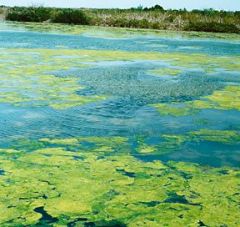
Algal blooms are caused by the photosynthetic, toxin-producing protists called dinoflagellates.
Potential harm: toxins can build up in clams or shellfish, which can be ingested by humans. The clams/shellfish are not harmed. |
|
|
Dinoflagellates |
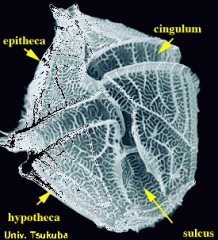
A single-celled organism with two flagella, occurring in large numbers in marine plankton and also found in fresh water. Some produce toxins that can accumulate in shellfish, resulting in poisoning when eaten. |
|
|
Foraminiferan |
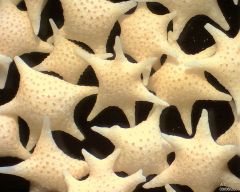
A single-celled planktonic animal with a perforated chalky shell through which slender protrusions of protoplasm extend. Most kinds are marine, and when they die, their shells form thick ocean-floor sediments. |
|
|
Primary Producers |
Organisms that produce organic compounds from inorganic compounds such as atmospheric or aquatic carbon dioxide, principally through the process of photosynthesis. |
|
|
Diatoms |
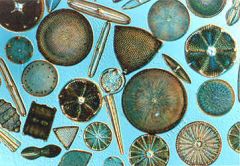
A single-celled alga that has a cell wall of silica. Many kinds are planktonic, and extensive fossil deposits have been found. |
|
|
Plankton |
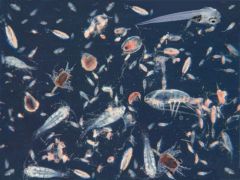
The small and microscopic organisms drifting or floating in the sea or fresh water, consisting chiefly of diatoms, protozoans, small crustaceans, and the eggs and larval stages of larger animals. Many animals are adapted to feed on plankton, especially by filtering the water. |
|
|
Phytoplankton |
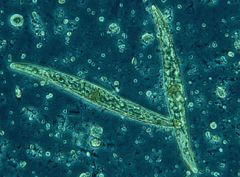
Plankton consisting of microscopic plants. |
|
|
Food Chain |
A series of steps in which organisms transfer energy by eating and being eaten. |

